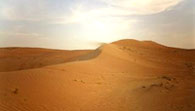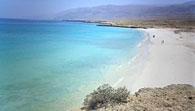The Weekend Australian - Desert Dreaming
August 22, 2009
Michelle Jana Chan discovers the true value of water and the pesky perils of sand.
This is the Arabia of Lawrence. A desert nation where I first begin to understand why Omanis whisper the word water with reverence. But the first day on the road, it all seems rather extreme.
We drive hundreds of kilometres from Muscat to reach Wadi Shab, a usually dry riverbed occasionally thrown into flummoxed ecstasy by a flash flood. The day I am there it is a pitiful trickle between pebbles and is packed with wadi-worshippers. Children are getting the soles of their feet wet, shrieking as they try to splash each other in the small area they have dammed. Parents spread picnics nearby, men on one side, women on the other. Grandparents crouch down on haunches, wetting their forearms, moistening cracked lips.

This is a special day out for these families, who have made the journey from Muscat, the capital. They have parked their airconditioned four-wheel-drives and walked up the valley in 35C heat to reach this wadi. Thalib, my Omani driver-guide, points between the rocks, looks up at me and smiles as he says, ‘‘Water.’’
This is tough to get my head around, after a few weeks of nonstop rain back home. Oman is hot and dry, no doubt, but I am not quite ready to get overwhelmed by a puddle. One of the men at the wadi says, ‘‘In summer months, we all go south with the hope we might be able to stand in the rain.’’ Way down in Salalah, on the Yemeni border, monsoon rains sometimes get lost on their way to India and clip the Arabian Peninsula, provoking a seasonal migration of city dwellers. In light of that, perhaps this pilgrimage to Wadi Shab isn’t quite so bizarre. I begin to understand the Omani respect for water. I learn to mimic Thalib and gently sip, rather than slug, drinks. Between reaching for my water bottle, I learn to stay thirsty for longer. When we are in the desert filling camels’ water troughs, I am paranoid about spilling any.
It is the Bedouins in the Wahiba, the 10,000sq km of the Northern Region Sands, who give me the most intensive lesson in the value of water. They still live the nomadic desert life here, albeit with a 4WD alongside their camels. Thalib takes me to spend a night with the Al Bedri family, based 60km inside the Wahiba. I pore over the map trying to find landmarks to locate us. There is still no sand in sight but we should have been close. ‘‘It will get hotter now. Drink some more,’’ says Thalib.
The desert rises up sharply. As the dirt track peters out, the scrubland suddenly morphs into 50m-high burnished-orange dunes. When Thalib puts his foot down and hears me gasp, he says he needs to drive at 100km/h so the tyres won’t sink. Watching his maniacal grin as he powers up and down the dunes, I am not sure that’s the whole truth.
The Al Bedri family’s camp is a tangle of temporary wooden structures and home to a husband, first wife and 11 children from three to 32 years old. About 100m away is a cage of chickens; another holds three-dozen rabbits. A half kilometre south, 200 long-haired goats are all named and separated by size into different pens. North are 100 bleating sheep, split in a similar way. Ranging loose around the camp are 20 camels with enigmatic smiles.
Just before sunset, the eldest son and I head off to feed the camels, carrying sacks of grain and squashing together dates to nourish expectant mothers. Calling them by name, Salman comes first, cantering over to us. This strong man curves his arm around the back of the camel’s head, tugs the ear, pulls its face towards him. He kisses its cheek, muttering soft Arabic words as he throws a rope bridle around its neck and blankets on its back.

In Bedouin culture, camels are an integrated part of the family. This isn’t about trade or herd size representing status. This is about the love between a nomadic people and the animals that transport them across the dunes, in the fermenting heat and whipping wind. I leap on the back of Salman and pad off into the sunset; it’s a scene straight out of a David Lean epic.
One night in the desert does me more good than 10 spa weekends. It isn’t just gazing out at the shifting horizons, as the sand slithers like spirits across the landscape. Or the soul-searching underneath a sky that makes me reconsider heaven. Or the noisy silence of a sandblasting wind that shuts you up and forces you to think. More than that, it is the Bedouin sense of timelessness and their seemingly uncomplicated lives. But while I envy their unfettered freedom, I am also desperate to fling myself into the sea and wash away the insidious grains of sand that get everywhere.
We leave the Al Bedri camp just after sunrise bound for the exquisite white beach of Fins, unmarked and unserviced but lapped by the bluest sea. The Omani coastline is wild and rugged, like a melange of building-site rubble, lava flow and moonscape, but there are intermittent moments of pure tropical beach indolence and Fins is one of those. I change in the back of the car, run to the sea, hurl myself into the surf and spend an hour digging sand out of my ears.
Back in Muscat, I return to the Chedi resort and quickly shower off the salt, in and out fast. I am finally appreciating the value of water in Oman. The next day, I book a last-minute fishing trip through a local tour company and speak to the sea captain by phone. He entertains me with tales of seriously massive marlin, mahi mahi and sailfish. We might see dolphin, too, or whales. God willing.
I meet Sahim Al Baatashy in central Muscat, just past the fish market. After staying with the Bedouins, all dusted in sand, Sahim is almost sparkling with a sheen of dried rock salt on his forearms and temples. I board his boat, something like a Boston whaler with a tarp stretched overhead, and the powerful twin 120hp engines throttle up.
Sahim has a couple of game-fishing rods on board for tourists but, like other local fishermen, he only uses a handline. He shows me a detailed map of the area, a laminated display of the fish in these waters as well as the logbook detailing previous catches. It is an impressive record with descriptions of tussles with fighting bluefin tuna weighing up to 90kg. Doing 30 knots we head out from the coast, around craggy Fahl Island and past oil tankers, to join a school of 20 other fishing boats. Almost all seem to be family or friends of Sahim. They call each other on mobile phones arguing about where the best fish are. Then, a squeal from me as we see a big old green turtle coming up for air.

Our engine startles it and it quickly dives downwards. I hang over the boat as Sahim shouts, ‘‘Can you see the dolphins?’’ I see the curves of their shiny backs and Sahim says the pod is about 1200-strong. I nearly fall off the boat.
A row of a dozen come flying out of the water synchronised in a splay of grey. On the right, spinners whirl about on themselves, drilling through the air. It is tough concentrating on checking lures while surrounded by hundreds of acrobatic dolphins. Every time I reel in a rod, I tangle the fishing line as another team flashes past. It is an extraordinary spectacle that Sahim insists is quite an ordinary day.
Finally, just at the close of the day, we hear that exhilarating sound of a line whirring out wildly. I grab the rod and toil with a 18kg bluefin tuna. By the time Sahim hauls it in over the side, my arms are limp and trembling. I can’t even hold the booty up for a photo to be taken. Sahim slices up the fish and I lie back in the sunshine, eating fresh sashimi and surrounded by dancing dolphins. Surely this could not be called an ordinary day in the Arabian Sea.




